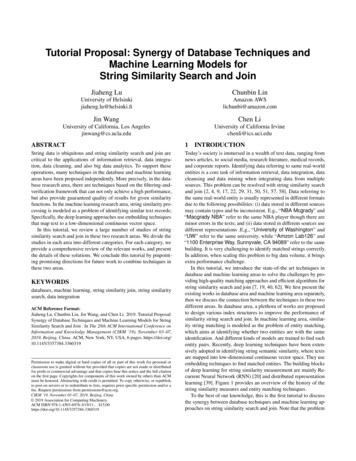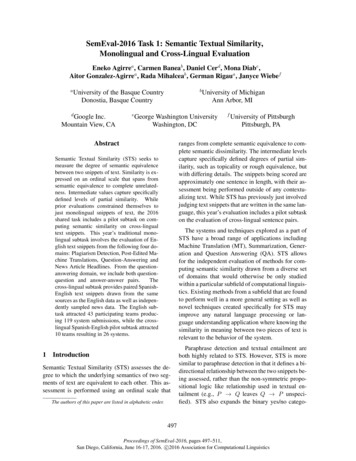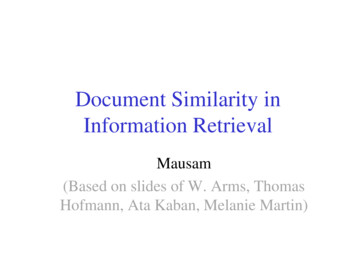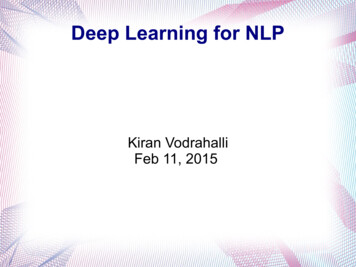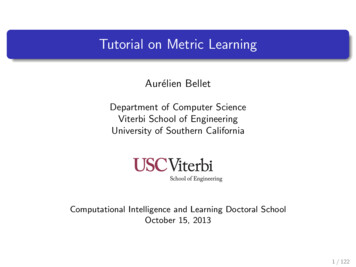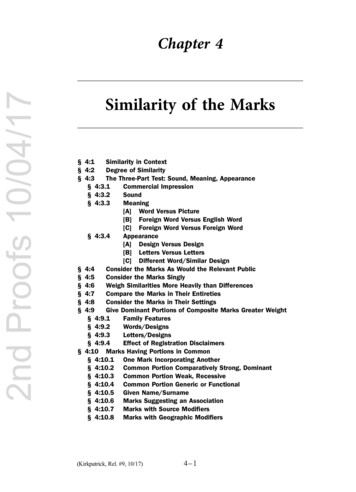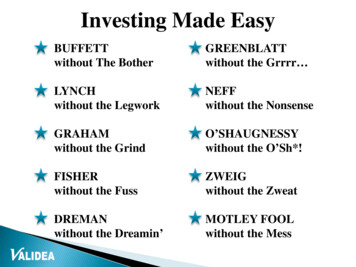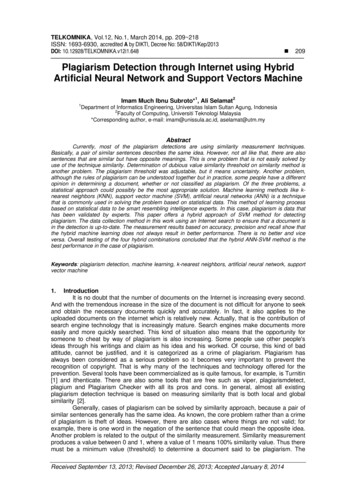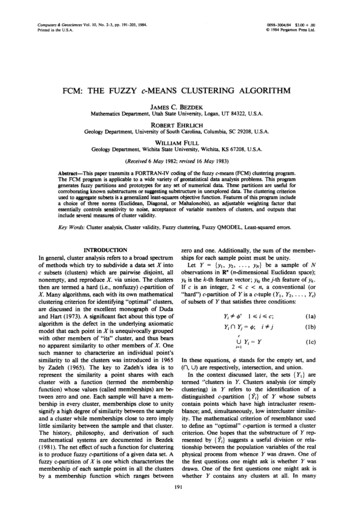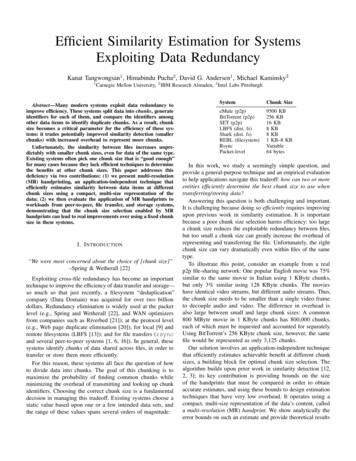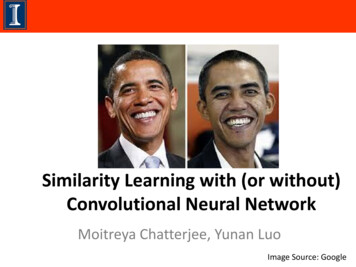
Transcription
Similarity Learning with (or without)Convolutional Neural NetworkMoitreya Chatterjee, Yunan LuoImage Source: Google
Outline – This Section Why do we need Similarity Measures Metric Learning as a measure of Similarity– Notion of a metric– Unsupervised Metric Learning– Supervised Metric Learning Traditional Approaches for Matching Challenges with Traditional MatchingTechniques Deep Learning as a Potential Solution Application of Siamese Network for differenttasks
Need for Similarity MeasuresSeveral applications of Similarity Measures exists in today’s world: Recognizing handwriting in checks. Automatic detection of faces in a camera image. Search Engines, such as Google, matching a query (could be text,image, etc.) with a set of indexed documents on the web.Image Source: Google, PyImageSearch
Notion of a Metric A Metric is a function that quantifies a“distance” between every pair of elements in aset, thus inducing a measure of similarity. A metric f(x,y) must satisfy the followingproperties for all x, y, z belonging to the set: Non-negativity: f(x, y) 0 Identity of Discernible: f(x, y) 0 x y Symmetry: f(x, y) f(y, x) Triangle Inequality: f(x, z) f(x, y) f(y, z)
Types of MetricsIn broad strokes metrics are of two kinds: Pre-defined Metrics: Metrics which are fullyspecified without the knowledge of data.E.g. Euclidian Distance: f(x, y) (x – y)T(x – y) Learned Metrics: Metrics which can only be definedwith the knowledge of the data.E.g. Mahalanobis Distance: f(x, y) (x - y) TM(x - y) ;where M is a matrix that is estimated from the data.Learned Metrics are of two types: Unsupervised : Use unlabeled data Supervised : Use labeled data
UNSUPERVISED METRIC LEARNING
Mahalanobis Distance Mahalanobis Distance weighs the Euclidiandistance between two points, by the standarddeviation of the data. f(x, y) (x - y) T -1(x - y); where is the meansubtracted covariance matrix of all data points.Image Source:GoogleChandra, M.P., 1936. On the generalised distance in statistics. In Proceedings of the NationalInstitute of Sciences of India (Vol. 2, No. 1, pp. 49-55).
SUPERVISED METRIC LEARNING
Supervised Metric Learning In this setting, we have access to labeled datasamples (z {x, y}). The typical strategy is to use a 2-step procedure: Apply some supervised domain transform. Then use one of the unsupervised metrics forperforming the mapping.Image Source:GoogleBellet, A., Habrard, A. and Sebban, M., 2013. A survey on metric learning for featurevectors and structured data. arXiv preprint arXiv:1306.6709.
Linear Discriminant Analysis (LDA) In Fisher-LDA, the goal is to project the data toa space such that the ratio of “between classcovariance” to “within class covariance” ismaximized. This is given by: J(w) maxw (wTSBw)/(wTSWw)Image Source:GoogleFisher, R.A., 1936. The use of multiple measurements in taxonomic problems. Annalsof eugenics, 7(2), pp.179-188.
TRADITIONAL MATCHING TECHNIQUES
Traditional Approaches for MatchingThe traditional approach for matching images,relies on the following pipeline:1. Extract Features: For instance, colorhistograms of the input images.2. Learn Similarity: Use L1-norm on thefeatures.Stricker, M.A. and Orengo, M., 1995, March. Similarity of color images. In IS&T/SPIE's Symposium on Electronic Imaging:Science & Technology (pp. 381-392). International Society for Optics and Photonics.
Challenges with Traditional Methods for MatchingThe principal shortcoming of traditional metriclearning based methods is that the featurerepresentation of the data and the metric arenot learned jointly.
Outline – This Section Why do we need Similarity MeasuresMetric Learning as a measure of SimilarityTraditional Approaches for Similarity LearningChallenges with Traditional Similarity MeasuresDeep Learning as a Potential Solution– Siamese Networks Architectures Loss Function Training Techniques Application of Siamese Network to differenttasks
Deep Learning to the Rescue!CNNs can jointly optimize the representationof the input data conditioned on the“similarity” measure being used, aka end-toend learning.Image Source:Google
Revisit the Problem Input: Given a pair of input images, we want toknow how “similar” they are to each other. Output: The output can take a variety of forms: Either a binary label, i.e. 0 (same) or 1(different). A Real number indicating how similar a pairof images are.
Typical Siamese CNN Input: A pair of input signatures. Output (Target): A label, 0 for similar, 1 else.ShareWeightsImage Source:GoogleBromley, J., Bentz, J.W., Bottou, L., Guyon, I., LeCun,Y., Moore, C., Säckinger, E. and Shah, R., 1993.Signature Verification Using A "Siamese" Time DelayNeural Network. IJPRAI, 7(4), pp.669-688.
SIAMESE CNN - ARCHITECTURE
Standard architecture of Siamese CNN D(x1) – D(x2) 2Simo-Serra, E., Trulls, E., Ferraz, L., Kokkinos, I., Fua, P. and Moreno-Noguer, F., 2015. Discriminative learning of deep convolutionalfeature point descriptors. In Proceedings of the IEEE International Conference on Computer Vision (pp. 118-126).
Popular Architecture Varieties No one “architecture” fits all! Design largely governed by what performs wellempirically on the task at hand.Inputs aremerged rightat the onsetInputs are first embeddedindependently, thenmerged.Zagoruyko, S. and Komodakis, N., 2015. Learning to compare image patches via convolutional neural networks. InProceedings of the IEEE Conference on Computer Vision and Pattern Recognition (pp. 4353-4361).
Siamese CNN – VariantsTRIPLET NETWORK D(f(A), f(B)) D(f(A), f(C)) Compare triplets in one go. Check if the sample in the topmost channel, is more similarto the one in the middle or the one in the bottom. Allows us to learn ranking between samples.Vo, N.N. and Hays, J., 2016, October. Localizing and orienting street views using overhead imagery. In EuropeanConference on Computer Vision (pp. 494-509).
SIAMESE CNN – LOSS FUNCTION
Siamese CNN – Loss Function Is there a problem with thisformulation?- Yes.- The model could learn toembed every input to thesame point, i.e. predict aconstant as output.- In such a case, every pair ofinput would be categorizedas a positive pair.Chopra, S., Hadsell, R. and LeCun, Y., 2005, June. Learning a similarity metric discriminatively, with application to faceverification. In Computer Vision and Pattern Recognition, 2005. CVPR 2005. IEEE Computer Society Conference on (Vol. 1, pp.539-546). IEEE.
Siamese CNN – Loss FunctionThe final loss is defined as :L loss of positive pairs loss of negative pairsChopra, S., Hadsell, R. and LeCun, Y., 2005, June. Learning a similarity metric discriminatively, with application to faceverification. In Computer Vision and Pattern Recognition, 2005. CVPR 2005. IEEE Computer Society Conference on (Vol. 1, pp.539-546). IEEE.
Siamese CNN – Loss FunctionWe can use different loss functions for the two types of inputpairs. Typical positive pair (xp, xq) loss: L(xp, xq) xp – xq 2(Euclidian Loss)Bell, S. and Bala, K., 2015. Learning visual similarity for product design with convolutional neural networks. ACMTransactions on Graphics (TOG), 34(4), p.98.
Siamese CNN – Loss Function Typical negative pair (xn, xq) loss :L(xn, xq) max(0, m2 - xn – xq 2) (Hinge Loss)Bell, S. and Bala, K., 2015. Learning visual similarity for product design with convolutional neural networks. ACMTransactions on Graphics (TOG), 34(4), p.98.
Choices of Loss Function Several choices for the Loss Functions are available.Choice depends on the task at hand. Loss Functions for 2-Stream Networks: Margin Based: Contrastive Loss: Loss(xp, xq, y) y * xp-xq 2 (1 –y) * max(0, m2- xp -xq 2) Allows us to learn a margin of separation. Extensible for Triplet Networks Non-Margin Based: Distance-Based Logistic Loss:P(xp, xq) (1 exp(-m) )/( 1 exp( xp - xq - m) )Loss(xp, xq, y) LogLoss(P(xp, xq), y) Good for quicker convergence.
Choices of Loss Function Contrastive Loss:For similar samples:Loss(xp, xq) xp-xq 2 Distance-Based Logistic Loss:For similar pairsP(xp, xq) (1 exp(-m) )/( 1 exp( xp - xq - m) ) - 1 quicklyLoss(xp, xq, y) LogLoss(P(xp, xq), y)Vo, N.N. and Hays, J., 2016, October. Localizing and orienting street views using overhead imagery. In European Conference on Computer Vision (pp. 494-509).
SIAMESE CNN – TRAINING
Siamese CNN – Training Update each of the two streams independently andthen average the weights. l/ D(x1) l/ D(x2) Does this technique remind us of anything?- Training in RNNs. Data augmentation may be used for more effectivetraining.- Typically we hallucinate more examples byperforming random crops, image flipping, etc.
Outline – This Section Why do we need Similarity MeasuresMetric Learning as a measure of SimilarityTraditional Approaches for Similarity LearningChallenges with Traditional Similarity MeasuresDeep Learning as a Potential SolutionApplication of Siamese Network to differenttasks– Generating invariant and robust descriptors– Person Re-Identification– Rendering a street from Different Viewpoints– Newer nets for Person Re-Id, ViewpointInvariance and Multimodal Data.– Use of Siamese Networks for SentenceMatching
APPLICATIONS
Discriminative Descriptors for Local PatchesLearn a discriminative representation of patches from differentviews of 3D pointsSimo-Serra, E., Trulls, E., Ferraz, L., Kokkinos, I., Fua, P. and Moreno-Noguer, F., 2015. Discriminative learning of deep convolutionalfeature point descriptors. In Proceedings of the IEEE International Conference on Computer Vision (pp. 118-126).
Deep DescriptorUse the CNN outputs of our Siamese networks as descriptorSimo-Serra, E., Trulls, E., Ferraz, L., Kokkinos, I., Fua, P. and Moreno-Noguer, F., 2015. Discriminative learning of deep convolutionalfeature point descriptors. In Proceedings of the IEEE International Conference on Computer Vision (pp. 118-126).
EvaluationComparison of area under precision-recall curveDatasetSIFT (Non-deep) 45LY0.2260.5580.608All0.3700.6930.756SIFT: hand-crafted features[23]: descriptor via convex optimizationRobustness to RotationSIFTOurs[23]Simo-Serra, E., Trulls, E., Ferraz, L., Kokkinos, I., Fua, P. and Moreno-Noguer, F., 2015. Discriminative learning of deep convolutionalfeature point descriptors. In Proceedings of the IEEE International Conference on Computer Vision (pp. 118-126).
Person Re-IdentificationCUHK03 Dataset
Quick TestAre they the same person?Ahmed, E., Jones, M. and Marks, T.K., 2015. An improved deep learning architecture for person re-identification. InProceedings of the IEEE Conference on Computer Vision and Pattern Recognition (pp. 3908-3916).
Person Re-IdentificationTruepositiveTruenegativeAhmed, E., Jones, M. and Marks, T.K., 2015. An improved deep learning architecture for person re-identification. InProceedings of the IEEE Conference on Computer Vision and Pattern Recognition (pp. 3908-3916).
Proposed ArchitectureAhmed, E., Jones, M. and Marks, T.K., 2015. An improved deep learning architecture for person re-identification. InProceedings of the IEEE Conference on Computer Vision and Pattern Recognition (pp. 3908-3916).
Proposed ArchitectureAhmed, E., Jones, M. and Marks, T.K., 2015. An improved deep learning architecture for person re-identification. InProceedings of the IEEE Conference on Computer Vision and Pattern Recognition (pp. 3908-3916).
Proposed ArchitectureCNNCNNAhmed, E., Jones, M. and Marks, T.K., 2015. An improved deep learning architecture for person re-identification. InProceedings of the IEEE Conference on Computer Vision and Pattern Recognition (pp. 3908-3916).
Proposed ArchitectureCNNLossCNNAhmed, E., Jones, M. and Marks, T.K., 2015. An improved deep learning architecture for person re-identification. InProceedings of the IEEE Conference on Computer Vision and Pattern Recognition (pp. 3908-3916).
Tied Convolution Use convolutionallayers to computehigher-order features Shared weightsAhmed, E., Jones, M. and Marks, T.K., 2015. An improved deep learning architecture for person re-identification. InProceedings of the IEEE Conference on Computer Vision and Pattern Recognition (pp. 3908-3916).
Cross-Input Neighborhood Differences Compute neighborhooddifference of two featuremaps, instead ofelementwise difference.Example: f, g are feature mapsof two input imagesf 5 7 21 4 2g 1 4 13 4 41 2 32 3 5Ahmed, E., Jones, M. and Marks, T.K., 2015. An improved deep learning architecture for person re-identification. InProceedings of the IEEE Conference on Computer Vision and Pattern Recognition (pp. 3908-3916).
Cross-Input Neighborhood Differences Compute neighborhooddifference of two featuremaps, instead ofelementwise difference.Example: f, g are feature mapsof two input imagesf 5 7 21 4 2g 1 4 13 4 41 2 3K(1,1) 5 55 52 3 5-1 42 3 4 43 2Ahmed, E., Jones, M. and Marks, T.K., 2015. An improved deep learning architecture for person re-identification. InProceedings of the IEEE Conference on Computer Vision and Pattern Recognition (pp. 3908-3916).
Cross-Input Neighborhood Differences Compute neighborhooddifference of two featuremaps, instead ofelementwise difference. A neighborhood-patchsize of 5 was used in thepaper:Ki(x,y) fi(x,y)I(5,5)-N[gi(x,y)]whereI(5,5) is a 5x5 matrix of 1s,N[gi(x,y)] is the 5x5 neighborhood ofgi centered at (x,y) Another neighborhooddifference map K’ wasalso computed where fand g were revised.
Patch Summary Features Convolutional layers with5x5 filters and stride 5(the size of neighborhoodpatch). Provides a high-levelsummary of the crossinput differences in aneighborhood patch.Ahmed, E., Jones, M. and Marks, T.K., 2015. An improved deep learning architecture for person re-identification. InProceedings of the IEEE Conference on Computer Vision and Pattern Recognition (pp. 3908-3916).
Across-Patch Features Convolutional layers with3x3 filters and stride 1. Learn spatial relationshipsacross neighborhooddifferencesAhmed, E., Jones, M. and Marks, T.K., 2015. An improved deep learning architecture for person re-identification. InProceedings of the IEEE Conference on Computer Vision and Pattern Recognition (pp. 3908-3916).
Across-Patch Features Fully connected layer. Combine informationfrom patches that are farfrom each other. Output: 2 softmax unitsAhmed, E., Jones, M. and Marks, T.K., 2015. An improved deep learning architecture for person re-identification. InProceedings of the IEEE Conference on Computer Vision and Pattern Recognition (pp. 3908-3916).
Visualization of Learned FeaturesAhmed, E., Jones, M. and Marks, T.K., 2015. An improved deep learning architecture for person re-identification. InProceedings of the IEEE Conference on Computer Vision and Pattern Recognition (pp. 3908-3916).
EvaluationMethodElementwise DifferenceNeighborhood DifferenceIdentification rate27.66%54.74%MethodRegular Siamese NetworkThis workIdentification rate42.19%54.74%
Street-View to Overhead-View Image MatchingVo, N.N. and Hays, J., 2016, October. Localizing and orienting street views using overhead imagery. In EuropeanConference on Computer Vision (pp. 494-509).
Street-View to Overhead-View Image MatchingQuery:MatchingImage:Vo, N.N. and Hays, J., 2016, October. Localizing and orienting street views using overhead imagery. In EuropeanConference on Computer Vision (pp. 494-509).
Quick TestWhich one is the correct match?Query ImageABCDEVo, N.N. and Hays, J., 2016, October. Localizing and orienting street views using overhead imagery. In EuropeanConference on Computer Vision (pp. 494-509).
CNN ArchitecturesClassification CNN:L(A, B, l) LogLossSoftMax(f(I), l)I concatenation(A, B)f AlexNetl {0, 1}, labelVo, N.N. and Hays, J., 2016, October. Localizing and orienting street views using overhead imagery.In European Conference on Computer Vision (pp. 494-509).
CNN ArchitecturesClassification CNN:L(A, B, l) LogLossSoftMax(f(I), l)I concatenation(A, B)f AlexNetl {0, 1}, labelSiamese-like CNN:L(A, B, l) l * D (1- l) * max(0, m – D)D f(A) – f(B) 2m margin parameterVo, N.N. and Hays, J., 2016, October. Localizing and orienting street views using overhead imagery.In European Conference on Computer Vision (pp. 494-509).
CNN ArchitecturesClassification CNN:L(A, B, l) LogLossSoftMax(f(I), l)I concatenation(A, B)f AlexNetl {0, 1}, labelSiamese-classification hybrid network:L(A, B, l) LogLossSoftMax(ffc(Iconv), l)Iconv concatenation(fconv(A), fconv(B))Siamese-like CNN:L(A, B, l) l * D (1- l) * max(0, m – D)D f(A) – f(B) 2m margin parameterVo, N.N. and Hays, J., 2016, October. Localizing and orienting street views using overhead imagery.In European Conference on Computer Vision (pp. 494-509).
CNN ArchitecturesClassification CNN:L(A, B, l) LogLossSoftMax(f(I), l)I concatenation(A, B)f AlexNetl {0, 1}, labelSiamese-like CNN:Siamese-classification hybrid network:L(A, B, l) LogLossSoftMax(ffc(Iconv), l)Iconv concatenation(fconv(A), fconv(B))Triplet network CNN:L(A, B, l) l * D (1- l) * max(0, m – D)D f(A) – f(B) 2m margin parameterL(A, B, C) max(0, m D(A, B) – D(A, C))(A, B) is a match pair(A, C) is a non-match pairVo, N.N. and Hays, J., 2016, October. Localizing and orienting street views using overhead imagery.In European Conference on Computer Vision (pp. 494-509).
Distance-based Logistic LossL(A, B, l) LogLoss (p(A, B), l)whereD f(A) – f(B) 2m margin parameterMatched/Nonmatchedinstances are pushed away fromthe “boundary” in theinward/outward direction.
Performance of Different NetworksMatching accuracyTest 8.886.886.4Siamese-like CNN:Triplet network CNN:Observation 1: Triplet network outperforms the Siamese by a large marginVo, N.N. and Hays, J., 2016, October. Localizing and orienting street views using overhead imagery. In EuropeanConference on Computer Vision (pp. 494-509).
Performance of Different NetworksMatching accuracyTest 487.6Siamese-like CNN:Triplet network CNN:Distance-based logistic(DBL) loss:L(A, B, l) LogLoss (p(A, B), l)Observation 2: Distance-based logistic (DBL) Nets significantly outperform theoriginal network.Vo, N.N. and Hays, J., 2016, October. Localizing and orienting street views using overhead imagery. In EuropeanConference on Computer Vision (pp. 494-509).
Performance of Different NetworksMatching accuracyTest setDenverDetroitSeattleSiamese Net85.683.282.9Triplet Net88.886.886.4Classification Net90.087.887.7Hybrid Net91.588.789.4Siamese-like CNN:Triplet network CNN:Classification CNN:Classification-siamesehybrid:Observation 3: Classification networks achieved better accuracy thanSiamese and triplet networks. Jointly extract and exchange information from both inputimages.Vo, N.N. and Hays, J., 2016, October. Localizing and orienting street views using overhead imagery. In EuropeanConference on Computer Vision (pp. 494-509).
MORE VARIANTS OF SIAMESE CNNs
Siamese CNN – VariantsSIAMESE CNN – INTERMEDIATE MERGING Combining at an intermediate stage allows us tocapture patch-level variability. Performing inexact (soft) matching yields superiorperformance. Match(X, Y) (X-μX)(Y- μY)/σXσYSubramaniam, A., Chatterjee, M. and Mittal, A., 2016. Deep Neural Networks with Inexact Matching for Person ReIdentification. In Advances in Neural Information Processing Systems (pp. 2667-2675).
Siamese CNN – VariantsSIAMESE CNN – INTERMEDIATE MERGINGResults: Handling Partial Occlusion:Baseline:ProposedMethod:Subramaniam, A., Chatterjee, M. and Mittal, A., 2016. Deep Neural Networks with Inexact Matching for Person ReIdentification. In Advances in Neural Information Processing Systems (pp. 2667-2675).
Siamese CNN – VariantsSIAMESE CNN – FOR VIEWPOINT INVARIANCEViewpoint invariance is incorporated by considering the similarity ofresponse across the individual streams.Kan, M., Shan, S. and Chen, X., 2016. Multi-view deep network for cross-view classification. In Proceedings of the IEEEConference on Computer Vision and Pattern Recognition (pp. 4847-4855).
Siamese CNN – VariantsSIAMESE CNN – FOR VIEWPOINT INVARIANCEResults on the CMU MultiPIE Dataset, forrecognition across 7 poses.Methods-45 deg-30 deg-15 deg15deg30 deg45 degCCA0.730.961.000.990.960.69KCCA (RBF)0.800.980.991.000.980.72FIP LDA0.930.961.000.990.960.90MVP 00.990.98Kan, M., Shan, S. and Chen, X., 2016. Multi-view deep network for cross-view classification. In Proceedings of the IEEEConference on Computer Vision and Pattern Recognition (pp. 4847-4855).
Siamese CNN – VariantsTWO STREAM CNN – FOR CROSS-MODAL EMBEDDINGMan in blackshirt playing aguitarTwo stream networks have also been used for cross-modal embeddingtasks. Here inputs from different modalities are mapped to a commonspace.Wang, L., Li, Y. and Lazebnik, S., 2016. Learning deep structure-preserving image-text embeddings. In Proceedings of theIEEE Conference on Computer Vision and Pattern Recognition (pp. 5005-5013).
Siamese CNN - VariantsApplication: Sentence completion, response to tweet, paraphraseidentificationword2vecExample:x : Damn, I have to work overtime this weekend!y : Try to have some rest buddy.y-: It is hard to find a job, better start polishing your resume.Hu, Baotian, et al., Convolutional neural network architectures for matching natural language sentences, NIPS 2014
DEMO OF SIAMESE NETWORK
Demo: ArchitectureMNIST Digit Similarity AssessmentFC1FC2(1024 units) (1024 units)FC3(2 units)Loss(contrastive loss)Code: @ywpkwon
Demo: Results130Code: @ywpkwon
Summary Quantifying “similarity” is an essentialcomponent of data analytics. Deep Learning approaches, such as “Siamese”Convolution Neural Nets, have shown promiserecently. Several variants of Siamese CNN are availablefor making our life easier for a variety of tasks.
Reading List– Bell, Sean, and Kavita Bala, Learning visual similarity for product design with convolutionalneural networks, ACM Transactions on Graphics (TOG), 2015– Chopra, Sumit, Raia Hadsell, and Yann LeCun, Learning a similarity metric discriminatively,with application to face verification, CVPR 2005– Zagoruyko, Sergey, and Nikos Komodakis, Learning to compare image patches viaconvolutional neural networks, CVPR 2015– Hoffer, Elad, and Nir Ailon, Deep metric learning using triplet network, arXiv:1412.6622– Simo-Serra, Edgar, et al., Discriminative Learning of Deep Convolutional Feature PointDescriptors, ICCV 2015– Vo, Nam N., and James Hays, Localizing and Orienting Street Views Using Overhead Imagery,ECCV 2016– Ahmed, Ejaz, Michael Jones, and Tim K. Marks, An Improved Deep Learning Architecture forPerson Re-Identification, CVPR 2015– Hu, Baotian, et al., Convolutional neural network architectures for matching natural languagesentences, NIPS 2014– Kulis, Brian, Metric learning: A survey, Foundations and Trends in Machine Learning, 2013– Su, Hang, et al., Multi-view convolutional neural networks for 3d shape recognition, ICCV 2015– Zheng, Yi, et al., Time Series Classification Using Multi-Channels Deep Convolutional NeuralNetworks, WAIM 2014– Yi, Kwang Moo, et al., LIFT: Learned Invariant Feature Transform, arXiv:1603.09114– Stricker, M.A. and Orengo, M. Similarity of color images. In IS&T/SPIE's Symposium onElectronic Imaging: Science & Technology (pp. 381-392), 1995.
Appreciate your kind attention!
Deep Learning as a Potential Solution Application of Siamese Network for different tasks. Need for Similarity Measures Image Source: Google, PyImageSearch Several applications of Similarity Measures exists in today's world: Recognizing handwriting in checks.
